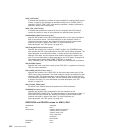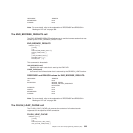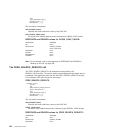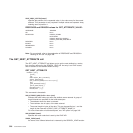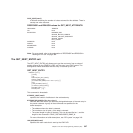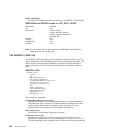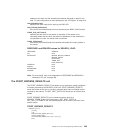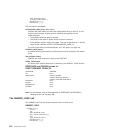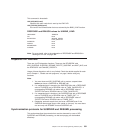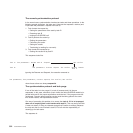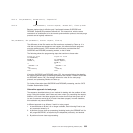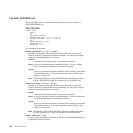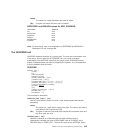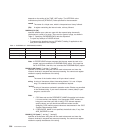address of the data, and the second word contains the length in bytes of the
data. For more information on block-descriptors, see “XPI syntax” on page 319.
LDAP_RESPONSE(name4)
specifies the return code that is sent by the LDAP API.
LDAP_SESSION_TOKEN(name4)
the name of the fullword token that was returned by the BIND_LDAP function.
SEARCH_TIME_LIMIT(name4)
specifies the time limit for the search (in seconds). If the search is not
successful within this time limit, the search is abandoned. If this parameter is
not specified or is zero, the search time is unlimited.
SEARCH_TOKEN(name4)
the name of the fullword token that identifies and holds the current position in
the search.
RESPONSE and REASON values for SEARCH_LDAP:
RESPONSE REASON
OK None
EXCEPTION INVALID_BUFFER_LENGTH
INVALID_TOKEN
NOTFOUND
TIMED_OUT
LDAP_INACTIVE
DISASTER None
INVALID None
KERNERROR None
PURGED None
Note: For more detail, refer to the explanation of RESPONSE and REASON in
“Making an XPI call” on page 308.
The START_BROWSE_RESULTS call
The START_BROWSE_RESULTS call allows you to browse the results (attributes
or entries) returned by the SEARCH_LDAP call. START_BROWSE_RESULTS
starts the browse at the first or only entry returned (there may be multiple entries
returned by the search). The GET_NEXT_ENTRY call allows you to retrieve other
entries.
START_BROWSE_RESULTS can be issued more than once for a
SEARCH_TOKEN. If the call is issued after a GET_NEXT_ENTRY or
GET_NEXT_ATTRIBUTE call, the browse position will be reset to the start of the
search results.
START_BROWSE_RESULTS
DFHDDAPX [CALL],
[CLEAR],
[IN,
FUNCTION(START_BROWSE_RESULTS),
SEARCH_TOKEN(name4),
[DISTINGUISHED_NAME(buffer-descriptor),]]
[OUT,
Chapter 3. The user exit programming interface (XPI) 329




